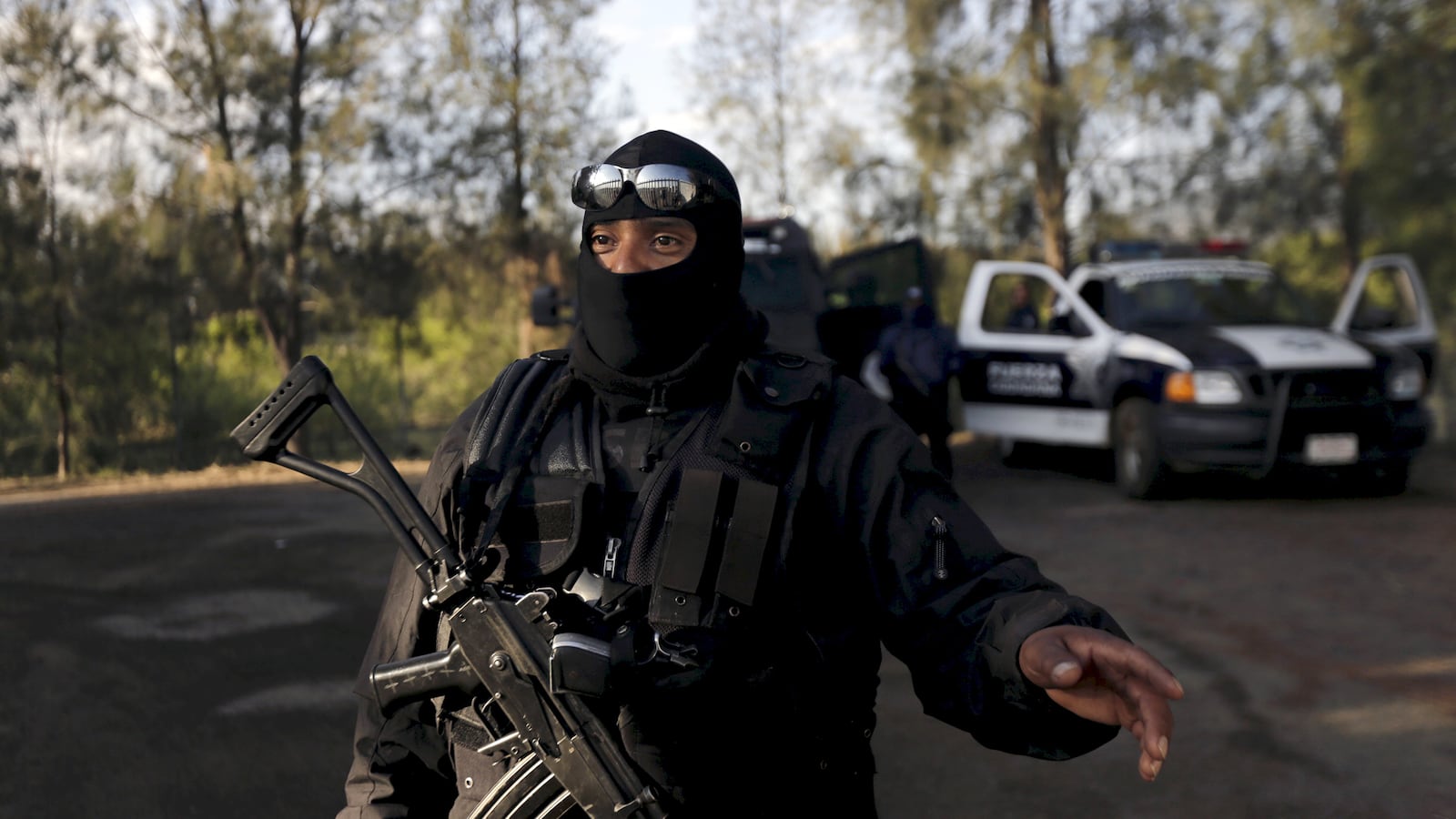At dawn on Friday, the Mexican armed forces and federal police swarmed a ranch near the town of Ecuandureo in the western state of Michoacán, sparking a three-hour gun battle. At one point, authorities radioed air and ground support and a Black Hawk helicopter hovered over the scene. Residents from the nearby town noticed a thick cloud of black smoke in the air in the direction of the violence.
In the end, 42 civilians encamped at the ranch perished in the assault, along with one federal police agent. The civilian dead are being identified as members of a crime syndicate that dominates the opium and methamphetamine production in the region.
The lopsided body count aroused suspicion, as did the fact that all the civilians at the ranch, with the exception of three taken into custody, were killed and none was wounded.
Several hours before the first comment from the Mexican government, photographs taken at the scene began circulating on social media. They showed the corpses of young men lying on the porch of a farmhouse or in the surrounding fields of a private ranch called Rancho El Sol. At least one of the victims had perished without time to put on shoes. Another was killed in his underwear.
One television producer and former war correspondent, Epigmenio Ibarra, who covered the civil wars in Central America in the 1980s, tweeted: “12 years covering wars. Never an army as accurate as the Mexican. Only kill shots, never any wounded.”
To a Mexican citizenry taught from overexposure to violence to examine the grisly forensic details of a crime scene, the weapons and ammunition photographed near the bodies seemed to have been planted after the fact. The corpse of a young man in one such photo lies face up, a high-powered assault rifle resting horizontally across his bare torso. In a separate photo, published by Aristegui News, another lifeless victim lies on his back with a cartridge belt for ammunition under his left hand; in a separate photo of the same corpse, the cartridge belt is nowhere to be found.
The Mexican authorities convened a press conference 12 hours after the battle concluded. National Security Commissioner Monte Alejandro Rubido said that gunmen had opened fire on a government patrol, provoking a pursuit that led back to the Rancho El Sol. The ranch is a 277-acre property in Michoacán only a few miles from the neighboring state of Jalisco. Rubido read a prepared statement and concluded the press conference without answering questions from reporters.
“A pursuit began that led to the ranch, the rest of the criminals inside the ranch started to attack the federal forces with intensity,” Rubido said.
Authorities found mattresses, blankets, clothing, and canned food on the porch of the farmhouse and in a nearby field indicative of a encampment on the property, although they have not said why the men were gathered there. The authorities made an inventory of the arsenal they seized at the scene: 36 assault rifles, two handguns, a .50 caliber sniper rifle, and a grenade launcher.
Commissioner Rubido referred to the civilian dead as members of a criminal organization, but he did not specify its name. However, the area is believed to be under the control of an organized crime outfit known as the Jalisco Cartel New Generation.
Until this year, the New Generation group was known—to the extent it was known at all—as the foil to the Knights Templar cartel which had dominated organized crime in the region from 2011 until now. The Mexican government has killed and captured a number of Templar leaders.
The holdout leaders of the Knights Templar, especially Servando Gómez, aka La Tuta, named the New Generation group as the primary beneficiary of the campaign against the Templars. Security analysts agreed, observing that the New Generation group has expanded its territory and gained in strength as the military campaign weakened the Knights Templar.
The New Generation group is the “least vulnerable, least attacked” of the major drug gangs in the region, the attorney general for the state of Jalisco,Luis Carlos Najera Gutierrez de Velasco, said in an interview with The Washington Post in April.
Whatever benefits the Jalisco group has enjoyed from its relative anonymity came crashing to an end on May 1 when it was accused of firing a rocket-propelled grenade that downed a Cougar helicopter and killed six of the 18 elite Mexican army Special Forces troops on board. The downing of the helicopter came on the same day as a coordinated a wave of 39 street blockades in the Pacific-coast states of Colima, Jalisco and Nayarit. The state government of Jalisco declared a state of emergency and urged residents not to leave their homes.
The Special Forces team, like the United States Joint Special Operations Command, is a highly trained and secretive unit that answers directly to the Mexican President Enrique Peña Nieto. Special Forces teams are most often deployed in what are called “tactical” or “surgical” strikes against high-value targets.
The top-secret nature of the military strike in Jalisco suggested that organized crime had been warned in advance of the helicopter convoy. The army initially covered up the fact that the six men killed were members of the Special Forces, likely to shield the president from political fallout from the debacle.
The Mexican government immediately set aside its surgical approach for an old-fashioned military occupation, deploying thousands of army regulars and heavy military equipment into the region on the same day the helicopter was downed. In what was dubbed Operation Jalisco, Commissioner Rubido vowed, “There will be significant use of force by the Mexican state against these criminals.”
The Mexican strategy during the past several presidential administrations has been to target the heads of criminal organizations. Numerous high-profile arrests have nevertheless failed to curb the drug-related violence in the country. The Guardian reported the death toll from Friday’s gun battle at Rancho El Sol was the highest yet from a confrontation involving Mexican security forces.
It is part of a national trend in which, increasingly, Mexican security forces are inflicting the largest body counts. Indeed, two of the more sensational acts of violence in the past year in Mexico have resulted not from two drug gangs battling one another, but rather from the authorities massacring large numbers of alleged criminals.
On June 30, 2014, the military killed 22 Mexican civilians in a shootout near the town of Tlatlaya. The military identified the victims as members of a criminal gang and said its soldiers had fired in self-defense after being attacked while on patrols. A closer inspection of the scene by forensic experts, however, found that the victims had been shot at point-blank range with their own guns and that the crime scene had been altered to cover up the extrajudicial executions.
In January, when 16 Mexican civilians were killed in a shootout in the city of Apatzingán, the federal police determined that nine of the victims died in “friendly fire,” meaning they were shot by their own side in the gun battle. A subsequent report by Proceso interviewed 39 separate eyewitnesses who did not recall seeing the eventual victims armed with more than sticks.
The Rancho El Sol military assault on Friday is the third major government assault on a civilian population in Mexico in the past 11 months.






